Potato
| Potato | |
|---|---|
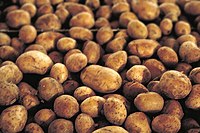
| |
| Scientific classification | |
| Kingdom: | |
| Division: | |
| Class: | |
| Subclass: | |
| Order: | |
| Family: | |
| Genus: | |
| Species: | S. tuberosum
|
| Binomial name | |
| Solanum tuberosum | |
The potato (Solanum tuberosum) is a perennial plant of the Solanaceae, or nightshade, family, grown for its starchy tuber. Potatoes are the world's most widely grown tuber crop, and its fourth crop in terms of fresh produce (after rice, wheat, and maize), but this ranking is inflated due to the high water content of fresh potatoes relative to that of other crops. The potato originated in the Andes, likely somewhere in present-day Peru or Bolivia though the potato known in daily use is from the island Chiloe in Chile. Potatoes form an important part of Andean culture, and the farmers grow many different varieties possessing a remarkable diversity of colors and shapes.
Botanical description
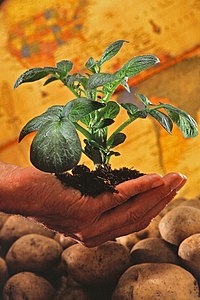
Potato plants have a low-growing habit and bear white to purple flowers with yellow stamens.
Buds called "eyes" appear on the surface of potato tubers. Since common varieties of potatoes do not produce seeds (they bear sterile flowers), propagation occurs by planting pieces of existing tubers, cut to include at least one eye. Confusingly, these pieces can bear the name "seed potatoes". The haulm or shaw of the potato plant may wither if early harvesting does not occur.
After potato plants flower, some varieties will produce small green fruit that look similar to green cherry-tomatoes. These produce seeds like other fruits. Insects can cross-pollinate the flowers of different potato plants. Each of the fruits can contain up to 300 true seeds. One can separate the seeds from the fruits by putting them in a blender on a slow speed with some water, then leaving them in water for a day so that the seeds will sink and the rest of the fruit will float. Potato fruit contains poisonous substances: one should not eat them. However, some horticulturists sell chimeras made by grafting a tomato plant onto a potato plant, which can produce both edible tomatoes and potatoes.
Distribution
Potatoes grow best in cool climates with good rainfall or irrigation such as in western Europe. But they are also widely grown in the subtropical lowlands of the Indo-Gangetic plains of India (as a winter crop) and in the highlands of southwest China (for example, Sichuan and Yunnan province) and in equatorial highlands of Java.
"Potato" etymology
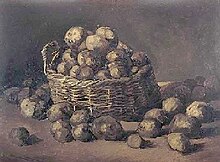
The Quechua word for potato is "papa". In the 16th century, the potato was introduced to Spain (the first record is from Sevilla, around the year 1570) and from there to the rest of Europe, North America, Africa and Asia. The name "potato" comes from the Spanish word "batata" meaning sweetpotato. Sweetpotato had arrived much earlier, Christopher Columbus himself had brought it back from the Caribean. Potato and sweetpotato (Ipomoea batatas) have only a very distant relationship with the sweet potato. But because the edible part of both crops is an underground organ (a root in the case of sweetpotato), they have often been confused.
In Spain, the potato is now called 'patata', although in some parts 'papa' is also uses. From Spain the potato went to Italy, where it was likened to truffels (mushrooms that grow underground), or "tartufoli" in Italian. The German ("kartoffel") and Russian word for potato are derived from this Italian origin. Another common name is "earth-apple": 'pomme de terre' in French; 'aardappel' in Dutch; 'תפוח אדמה' ('tapuach adama') in Hebrew (This is the most common word used in hebrew, though it is not the correct one. The correct translation is "תפוד" [Tapud].); and 'Erdapfel' in Austrian German. This name is possibly used because raw potato resembles apple in everything but taste. (A common children's scientific experiment is to see if a person can tell the difference between the two with his nose stopped). The term "earth-apples" should not be confused with "earth-pears" (Helianthus tuberosum) which are also known as topinambour or 'Jerusalem Artichoke'.
Another common naming approach is to refer to its origin: 'foreign tuber' in China, 'Batavian tuber' in Japan, after Batavia (now Jakarta) on Java. In Czechia they are called "brambori", after the German city of Brandenburg. In Brazil, batata is the term used, but its full name is actually batata inglesa (lit. "English potato"). In the United States people sometimes refer to the "Irish potato", a reference to the source of potato's introduction into the British North American colonies. The term Irish potato helps distinguish the crop from the sweetpotato, but then the sweetpotato is commonly called "yam" in the United States, whereas that is yet an entirely different crop.
A number of popular alternatives or shortened forms exist in English, such as taters or murphies, the latter usually associated with Scotland. Potatoes are commonly known as spuds in parts of the United States and other English-speaking areas. The exact origin of the term is unclear. It may refer to a "spudder," a shovel-like tool used to harvest potatoes, or to a wooden barrel sorters would put small potatoes into when sorting for larger ones. [1].
In the Irish language the word used for potato is práta, plural prátaí (though this has become fata/fataí in Connacht Irish). In Ireland this word is sometimes used by non-Irish speakers as a nickname for potatoes.
History and spread
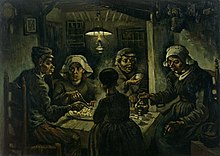
Origins
There are about 180 different wild potato species. They occur from the southwestern USA through the highlands of Mexico, Central America, the Andes to Argentina, Uruguay, and Chile. Most species diversity is found in the Mexican transvolcanic belt (near Mexico City, and in the central-southern Andes (central Peru to Bolivia).
The ancestor of our cultivated potato was domesticated in the Andes. Recent genetic analysis has shown that the potato was cultivated from one progenitor in an area of southern Peru, and the cultivated species then spread from there. However, the plant may have been used in other parts of the world, and it appears that native americans collected or even cultivated them in what is now New Mexico (USA). Archeological evidence suggests that Andean people have cultivated the potato for at least 7,000 years. In pre-Columbian times it was widely grown in the Andes (at high elevations where it is too cold for maize) and in parts of Chile (Chiloe island in particular).
Spain
The first European record of the potato came in 1537 from the Spanish conquistador Castellanos, who discovered the tuber when his group raided a village in South America. After the potato was brought over to Spain, it gradually spread across Europe. Initially the food was treated by distrust, and was believed to be unhealthy and even un-Christian. This prevented widespread acceptance for a period, although it began to be promoted as a medicinal plant.
During periods of warfare, the potato proved beneficial. Grain crops could be burned down by marching armies, but potatoes lay underground and were generally unaffected by military foraging. This led to increased use by the peasantry of areas in Germany, which had been particularly badly ravaged during the Thirty Years' War.
England
Popular legend has long credited Sir Walter Raleigh with first bringing the potato to England. History suggests Sir Francis Drake as a more likely candidate. In 1586, after battling the Spaniards in the Caribbean, Drake stopped at Cartagena in Colombia to collect provisions — including tobacco and potato tubers. Before returning to England he stopped at Roanoke Island, where the first English settlers had attempted to set up a colony. The pioneers returned to England with Drake, along with the potatoes. Agriculturalists in Europe soon found potatoes easier to grow and cultivate than other staple crops, such as wheat and oats; potatoes produce more food energy than any other European crop for the same area of land and require only a shovel for harvesting.
Ireland

The potato became such an important food for the Irish that the popular imagination automatically associates it with them today, but its early history in Ireland remains obscure. One speculation has it that the potato may have originally arrived in Ireland washed ashore from wrecked galleons of the Spanish Armada (1589). Another story credits the introduction of the potato in Ireland to Sir Walter Raleigh, who did finance transatlantic expeditions, at least one of which made landfall at Smerwick, County Kerry in October, 1587, but no record survives of what botanical specimens it may have carried or whether they thrived in Ireland. Some stories say that Sir Walter first planted the potato on his estate near Cork. A 1699 source (over one century after the event) says 'The potato .... Was brought first out of Virginia by Sir Walter Raleigh, and he stopping at Ireland, some was planted there, where it thrived well and to good purpose, for in three succeeding wars, when all the corn above ground was destroyed, this supported them; for the soldiers, unless they had dug up all the ground where they grew, and almost sifted it, could not extirpate them.' [2]
Whatever the source, the potato became popular in Ireland both because of its high productivity and because of the advantages of both growth and storage hidden underground. English landlords also encouraged potato-growing by Irish tenants because they wanted to produce more wheat — if the Irish could survive on a crop that took less land, that would free a greater area for wheat production. By 1650 potatoes had become a staple food of Ireland, and they began to replace wheat as the major crop elsewhere in Europe, serving to feed both people and animals.
A single devastating event however, looms large in the Irish history of potatoes — the Irish potato famine. In the 1840s a major outbreak of potato blight, a plant disease, swept through Europe, wiping out the potato crop in many countries. The Irish working class lived largely on the unpalatable but fertile 'lumper', and when the blight reached Ireland their main staple food disappeared.
Though Ireland grew a variety of crops at this time, most went as exports to Europe for sale at a higher price. In fact, during the Potato Famine, Ireland remained a net exporter of food stuffs. However the exported foods remained too expensive for the Irish themselves to afford. Historians continue to debate the roles that English rule and European market prices played in causing the famine.
Ultimately the famine led to almost a million deaths, and the subsequent emigration of millions more Irish (see Irish diaspora). Emigration from the German states also grew, although central Europe did not suffer the mass starvation that occurred in Ireland.
Continental Europe
By the seventeenth century the potato had become firmly established as a staple of Europe's poor, leading richer people to spurn it, although this changed gradually, with Antoine-Augustin Parmentier's persuading King Louis XVI of France of the value of the crop which he was fed as a prisoner of Prussia during the Seven Year's War. The soup potage Parmentier and shepard's pie hachis Parmentier takes their name from the great horticulturalist. By the end of the 18th century the potato had become popular in France, due to the advocacy of Parmentier.
Today, potatoes grow widely in Europe, especially in North European countries such as the British Isles, Germany, Poland, and Russia, due to their ability to thrive in cold, damp climates. Potatoes figure in many national dishes of this region. Because the potato grew so well in Northern Europe, it may have contributed to the population-explosion there in the 19th century - though not in other centuries.
In Russia, potatoes met with initial suspicion: the people called them "the Devil's apples" because of folklore surrounding things which grow underground or which have associations with dirt.
United States
Although potatoes were called "potatoes of the Virginia" by early English botanists, they were in fact from South America, not Virginia. The first mention of potatoes in North America comes in an account of Scots-Irish settlers in Londonderry, New Hampshire during 1719. Potatoes were used for food and as animal feed. The first potatoes planted in Idaho were in 1836 but it was not until after the development by Luther Burbank of the Russet potato that potatoes became a major Idaho crop, at the beginning of the 20th century. While potatoes are grown commercially in at least 35 states, most potatoes are grown in the north. Idaho grows 30% of the total U.S. potato crop, Washington another 20%; Michigan, Wisconsin, North Dakota, Colorado, and Oregon round out the top producers.
Varieties

Potatoes' skins come in the colors brown, yellow, pink, red, and purple (sometimes called "blue"). Their flesh may appear white or may reflect the color of the skin. The market calls small types "fingerlings" or "new" potatoes, larger potatoes may class as "earlies" or "main crop", with the "main crop" referring to varieties that will store well. Potato retailers may label different types as:
- "boiling", indicating that they retain some shape when boiled
- "baking", indicating that they only hold their shape if baked
- "roasting", indicating good flavor when roasted
- "salad" to indicate suitability for salad use (often firm and waxy-fleshed when boiled)
- "mashing" to indicate that when mashed they form a smooth consistency, neither fibrous nor grainy
Common North American potato varieties include:
- Russet Burbank — large, brown skin, white-fleshed, developed by Luther Burbank
- Yellow Finn — small, with yellow skin and flesh
- Red Gold — red skin, yellow flesh
- German Butterball — a yellow-fleshed small oval potato. Won first place in Rodale's Organic Gardening "Taste Off"
- Yukon Gold — yellow skin and flesh
In the United States the term "Idaho potato" often refers to the Russet Burbank, the principal variety grown in Idaho, that country's principal potato-growing region. The term also occurs generically for other potatoes grown in Idaho.
Common British potato varieties include:
- Maris Piper — a good general-purpose white main-crop potato, not suitable for salads. The favourite potato of chip shops
- King Edward — the best roasting potato, often served with the Sunday roast, white, main-crop
- Desiree — a red-skinned main-crop potato, a favourite with allotment-holders because of its resistance to disease
- International Kidney — trademarked as Jersey Royal, a salad new potato, grown on the island of Jersey and in Spain
- Pink Fir Apple — a pink-skinned salad potato which grows in irregular shapes
- Golden Wonder — famous Scottish frying potato, used to make the eponymous crisps
- Kerr's Pink — bred in Scotland: an excellent potato for boiling.
- Comber Spuds — grown in Comber, Northern Ireland, these 'new' potatoes are picked in April and best used sautéed or for making champ.
Many potato varieties in the U.K. originated on breeding stations which give part of the potato's name. Thus the Maris breeding station developed the above-mentioned Maris Piper and the Maris Peer. Another well-known station, Pentland, produced such varieties as Pentland Javelin and Dell.
Common French varieties include
- Amandine — a variety of early potato, descended from the varieties Charlotte and Mariana. Bred in Brittany, France, it entered the national list of potato varieties in 1994. Amandine shaws typically produce long tubers with very pale, unblemished skin. Their flesh, firm and also very pale, contains comparatively little starch. Amandine potatoes have become popular in Switzerland.
Other varieties include:
Peru, as the native area of origin for potatoes, can offer a wide range of more than 4200 varieties.
Food value
| |||||
| †Percentages estimated using US recommendations for adults,[1] except for potassium, which is estimated based on expert recommendation from the National Academies.[2] |
Potatoes have a high carbohydrate content and include protein, minerals (particularly potassium, calcium), and vitamins, including vitamin C. Freshly harvested potatoes retain more vitamin C than stored potatoes.
New and fingerling potatoes offer the advantage that they contain fewer toxic chemicals. Such potatoes offer an excellent source of nutrition. Peeled, long-stored potatoes have less nutritional value, especially when fried, although they still have potassium and vitamin C.
Potatoes also provide starch, flour, alcohol (see Poitin), dextrin, and livestock fodder.
Cooking
Cooks and chefs can prepare potatoes for eating in numerous ways: either with their skin on or peeled, whole or cut into pieces, and with seasonings or without. The only requirement involves cooking — to break down the starch and make them edible. Most end-consumers eat potatoes hot, but several basic potato recipes involve cooking the potatoes and then eating them cold — potato salad and potato crisps (called "potato chips" by most English speakers). One of the most common presentation methods involves mashing potatoes: peeling, boiling, then mashing and mixing with butter, cream, or other seasonings before serving.
Mashed potatoes form a major component of several traditional dishes from the British Isles such as shepherd's pie, bubble and squeak, champ and the 'tatties' which accompany haggis. They are also often sautéed to accompany a meal.
In the United States, potatoes have become one of the most widely-consumed crops, and thus have a variety of preparation methods and condiments. One popular favorite involves a baked potato with cheddar cheese (or sour cream and chives) on top, and in New England "smashed potatoes" (a chunkier variation on mashed potatoes but retaining the peel) have great popularity.
Other presentations or dishes may see potatoes baked whole; boiled; steamed; cut into cubes and roasted; scalloped diced or sliced and fried (home fries); grated into small thin strips and fried (hash browns); grated and formed into dumplings, Rösti or potato pancakes; and cut into long, thin pieces and fried or baked (French fries, called "chips" in the UK). Potatoes also serve to make a type of pasta called gnocchi. Potatoes form one of the main ingredients in many soups such as the pseudo-French vichyssoise and Albanian potato and cabbage soup. Potato chunks also commonly appear as a stew ingredient.
In Scandinavia, especially Sweden and Finland, newly harvested, early ripening varieties are considered a special delicacy. Cooked and served with dill, these "new potatoes" are traditionally consumed together with pickled Baltic herring.
A traditional Canary Islands dish is Canarian Wrinkly Potatoes or Papas arragudas.
Toxic compounds in potatoes

Potatoes contain glycoalkaloids, toxic compounds, of which the most prevalent are solanine and chaconine. Cooking at high temperatures (over 170 °C or 340 °F) partly destroys these. The concentration of glycoalkaloid in wild potatoes suffices to produce toxic effects in humans. Glycoalkaloids occur in the greatest concentrations just underneath the skin of the tuber, and they increase with age and exposure to light. Glycoalkaloids may cause headaches, diarrhea, cramps and in severe cases coma and death; however, poisoning from potatoes occurs very rarely. Light exposure also causes greening, thus giving a visual clue as to areas of the tuber that may have become more toxic; however, this does not provide a definitive guide, as greening and glycoalkaloid accumulation can occur independently of each other. Some varieties of potato contain greater glycoalkaloid concentrations than others; breeders developing new varieties test for this, and sometimes have to discard an otherwise promising cultivar.
Breeders try to keep solanine levels below 0.2 mg/g (200 ppmw). However, when even these commercial varieties turn green, they can approach concentrations of solanine of 1 mg/g (1000 ppmw). Some studies suggest that 200 mg of solanine can constitute a dangerous dose. This dose would require eating 1 average-sized spoiled potato or 4 to 9 good potatoes (over 3 pounds or 1.4 kg) at one time. The National Toxicology Program suggests that the average American consumes 12.5 mg/person/day of solanine from potatoes. Dr. Douglas L. Holt, the State Extension Specialist for Food Safety at the University of Missouri - Columbia, notes that no reported cases of potato-source solanine poisoning have occurred in the U.S. in the last 50 years and most cases involved eating green potatoes or drinking potato-leaf tea.
Solanine is also found in other plants, in particular the deadly nightshade. This poison affects the nervous system causing weakness and confusion. See Solanine for more information.
See also List of poisonous plants
Cultivation
Potatoes are generally grown from the eyes of another potato and not from seed. Home gardeners often plant a piece of potato with two or three eyes in a hill of mounded soil. Commercial growers plant potatoes as a row crop using seed tubers, young plants or microtubers and may mound the entire row.
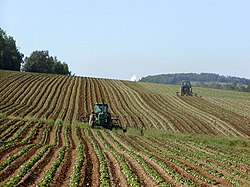
Fort Fairfield, Maine
At harvest time, gardeners generally dig up potatoes with a three-prong "grape" or spading fork, but in larger plots, the plough can serve as the most expeditious implement for unearthing potatoes. Commercial harvesting is typically done with large potato harvesters which scoop up the plant and the surrounding earth. This is transported up an apron chain consisting of steel links several feet wide. This separates some of the dirt. The chain deposits into an area where further separation occurs. Different designs employ different systems at this point. The most complex designs use vine choppers and shakers as well as a blower system to separate the potatoes from the plant. The result is then usually run past workers who continue to sort out plant material, stones, and rotten potatoes before the potatoes are continuously delivered to a wagon or truck. Further inspection and separation occurs when the potatoes are unloaded from the field vehicles and put into storage.
It is important to harvest potatoes before heavy frosts begin because field frost damages potatoes in the ground and even cold weather makes potatoes more susceptible to bruising and possibly later rotting which can quickly ruin a large stored crop.
Production
According to the Food and Agriculture Organization, the worldwide production of potatoes in 2005 was 322 million metric tons[3] which makes it the fifth highest production crop in the world. The leading producers of potatoes in 2005 were:
| Country | Production, in million metric tons |
|---|---|
| China | 73 |
| Russia | 36 |
| India | 25 |
| Ukraine | 19 |
| United States | 19 |
| Germany | 11 |
| Poland | 11 |
References and external links
- World Geography of the Potato at http://www.lanra.uga.edu/potato/
- Reference for potato history: The Vegetable Ingredients Cookbook by Christine Ingram, Lorenz Books, 1996 ISBN 1859672647
- The History and Social Influence of the Potato by Redcliffe N. Salaman ISBN 0521316235
- Potato nutrition facts
- Hamilton, Andy & Dave, (2004), Potatoes - Solanum tuberosums retrieved on 4 May 2005
- BBC: DNA shows all modern potatoes can trace roots back to Peru
- Spooner, D.M. et al. 2005. A single domestication for potato based on multilocus amplified fragment length polymorphism genotyping. Proc. Natl. Acad. Sci. USA, Published online before print October 3, 2005
- GLKS Potato Database
- Health Benefits of Potato
- Potato Recipe (almost 3,000 recipes) Collection
Template:Link FA Template:Link FA
- ^ United States Food and Drug Administration (2024). "Daily Value on the Nutrition and Supplement Facts Labels". FDA. Archived from the original on 2024-03-27. Retrieved 2024-03-28.
- ^ National Academies of Sciences, Engineering, and Medicine; Health and Medicine Division; Food and Nutrition Board; Committee to Review the Dietary Reference Intakes for Sodium and Potassium (2019). Oria, Maria; Harrison, Meghan; Stallings, Virginia A. (eds.). Dietary Reference Intakes for Sodium and Potassium. The National Academies Collection: Reports funded by National Institutes of Health. Washington, DC: National Academies Press (US). ISBN 978-0-309-48834-1. PMID 30844154. Archived from the original on 2024-05-09. Retrieved 2024-06-21.
